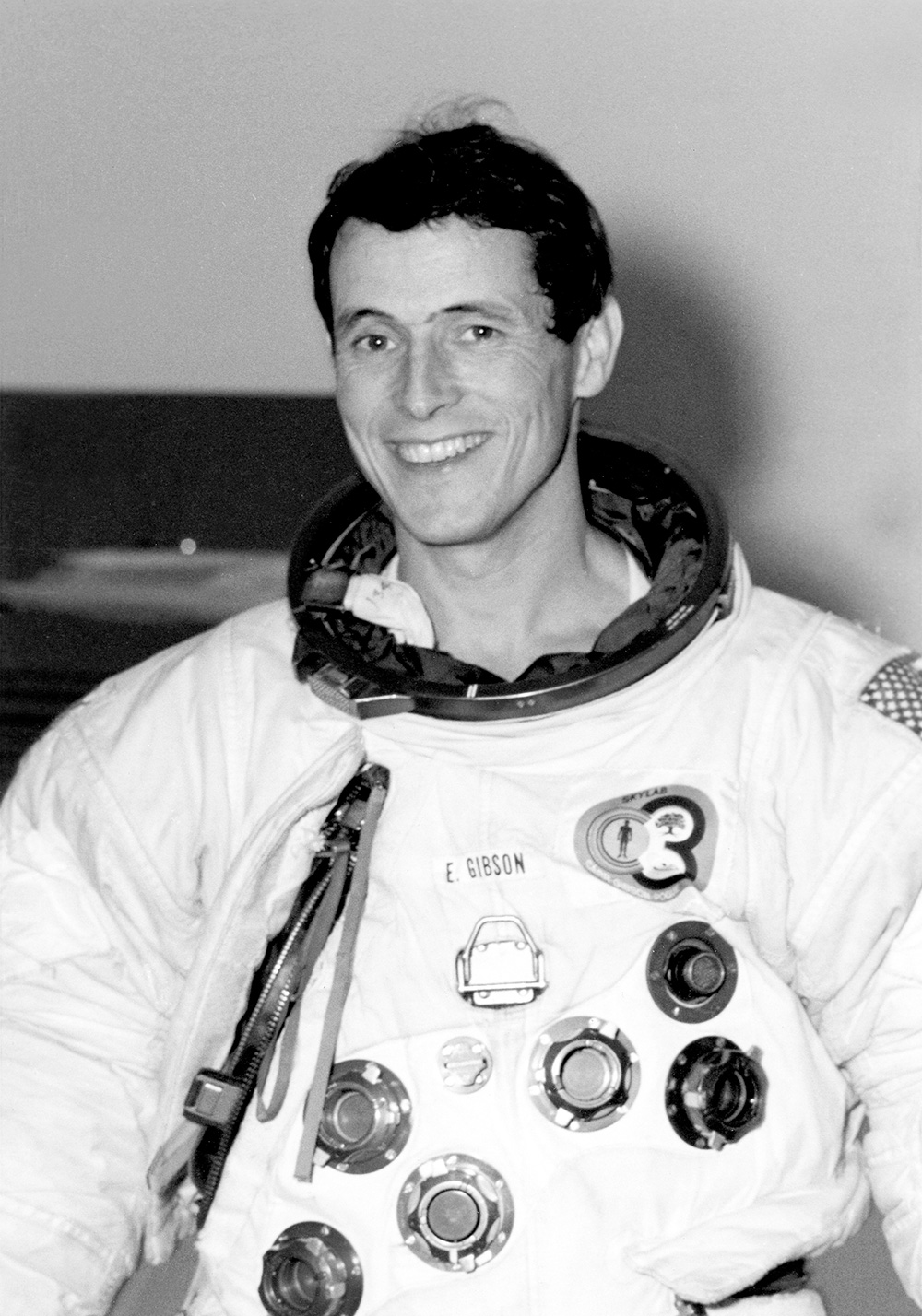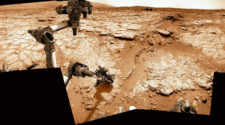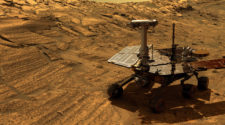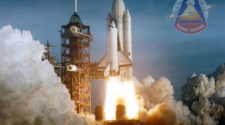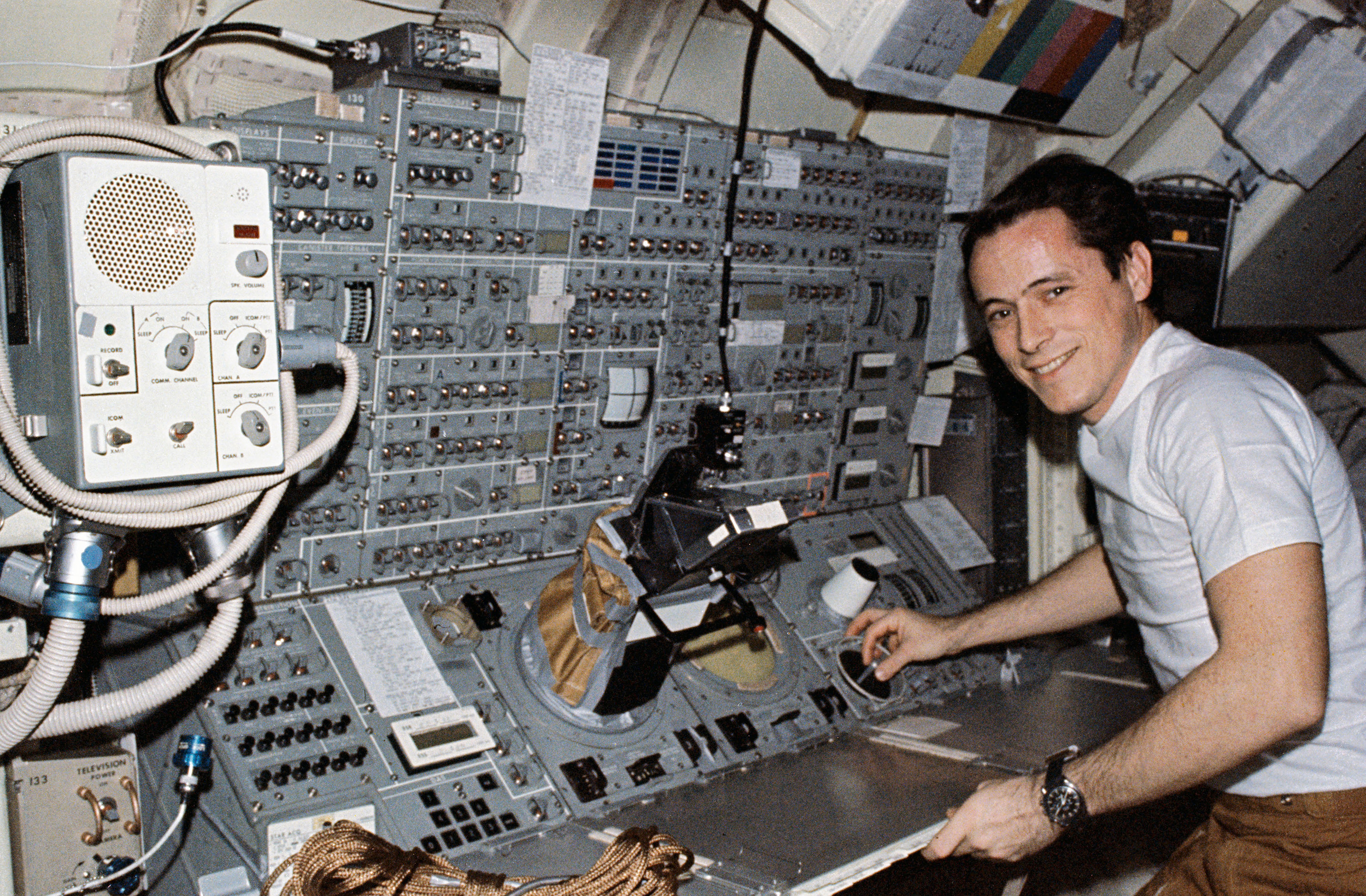
America’s first space station, Skylab was launched into orbit on a Saturn V rocket in May of 1973. Three manned missions to the outpost were immensely successful. Repairs made to the orbital station during several spacewalks ultimately proved that it was possible for astronauts to conduct work in outer space, which gave NASA the confidence to eventually follow Skylab with on-orbit assembly of the International Space Station.
Astronaut-scientist Edward G. Gibson, who earned a doctorate in engineering with a minor in physics, was the Science Pilot for the third and final crewed mission to Skylab in late 1973, returning to Earth in February of 1974. Being the last humans to board Skylab, the crew was kept busy from day one, but still found time to enjoy the view.
Gibson: “Well, let’s see. What was it like? How do I ever give you a concise answer to that one? The beginning, of course, is always exciting, the liftoff on through rendezvous and docking. Once you get inside the station, you encounter two challenges. First, there is a lot of work to get started. Second, you also have to be careful that you don’t move too fast or you’ll get space sickness. Jerry [Gerald Carr], who was the commander, and myself, did alright on that. Bill [William Pogue], the Pilot, did get sick and he was sick for a number of weeks, which slowed him down. That’s just the nature of the animal unfortunately and hard to predict.
“We got up there and immediately had a lot of work to do because the previous crew had done a great job. They started slow and finished fast. Even though Ground Control tried to make several allowances, they really started us a little faster than we were ready for. We ended up being behind the scheduled activities as opposed to ahead of it, which is where you always like to be.
“We sorted through that and by the time the smoke cleared at the end of the mission we had accomplished the same average work per day that the previous crew had done.
“You never get tired of looking out the window. That’s something I wish everyone could do. If people could experience zero gravity while looking out the window, they would have a different perception of our home planet. Pictures are great, but they don’t really give you the same physical and intellectual perspective.”
For all astronauts, reentering the Earth’s atmosphere and adapting to gravity once again is always a tough task, both mentally and physically.
Gibson: “After you burn the engine and you slow up just slightly, you gradually start dropping down toward the atmosphere. The first thing you notice is a violet glow, a very soft glow.
“Once we got down low and slow enough that we could pop our drogue chutes and then the main chutes, I thought, ‘Well, we’re back to one gravity.’ But I still felt like we were pulling three Gs. Without any gravity for three months, it was tough for the body to get used to it again. It was a rude awakening and disappointment actually.
“When we finally hit the water, it was a good firm slap. We flipped upside-down so we had to inflate airbags that popped us upright. That was probably the most uncomfortable part of the whole flight: bobbing up and down on the ocean in a closed, damp cabin, hanging in the straps with the heat of reentry soaking back in. There was no imminent danger to it. It was just uncomfortable.
“After you flip upright you are pulled up onto the carrier deck. Immediately, as you are laying there and then when you try to get out, you feel more disappointment, at least I did, because I realized that for the rest of my life, no matter how hard I push off, I can no longer float. And no matter where I go, once again, I have to haul along tremendous amounts of meat and bone. Rolling over at night turns into a real engineering challenge.
“You take your movements for granted now because your body and your mind have adapted to it. But after not having to do that for a while, it is like being down here and having lead weights tied all over your body.
“It takes around two hours before you can walk stably, but you still have to walk with your feet wide apart.
“After two days, you could move around pretty well. And then you got close to preflight levels of stability after around two weeks, so from that standpoint we were pretty good.”
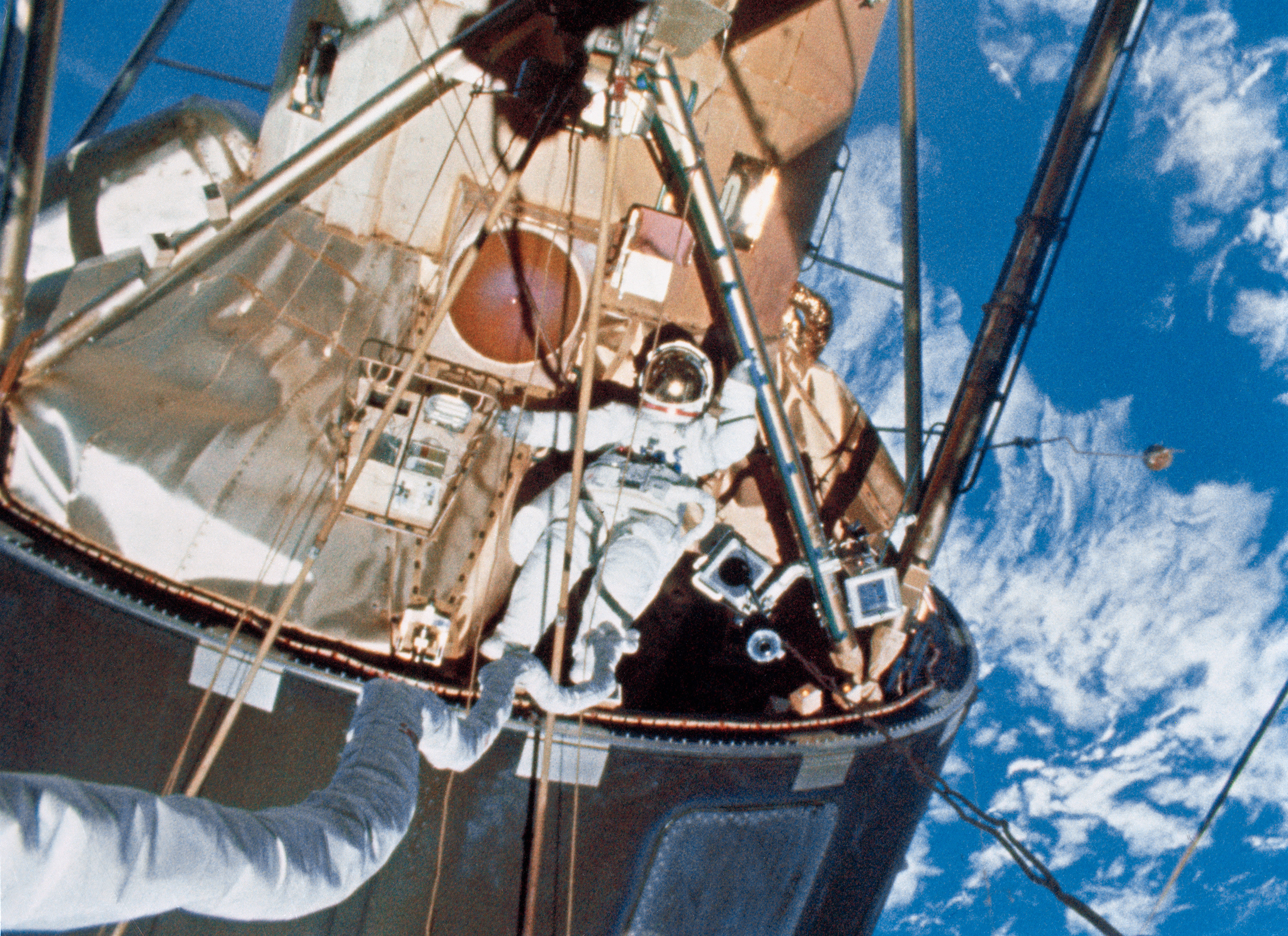
Luckily for the Skylab residents, NASA had begun to understand the importance of exercise while in orbit and provided the crew with crude, but functional, workout devices.
Gibson: “We had a bicycle Ergometer, which was used primarily to keep the cardiovascular system in shape. That worked pretty well. We had Exergenies, essentially resistance devices, that were like lifting weights back down here on the ground.
“We also had what I call a “poor-man’s treadmill.” Right now they have folks living up there in luxury with a first-class treadmill. We didn’t have that available so Bill Thornton, who was an ingenious doctor that later flew on some Shuttle flights, came up with a way to hold us down to the deck with about our own weight by putting elastic straps over our shoulders and then a thin Teflon sheet about two feet wide and four feet long under our feet. In that arrangement we could walk or run by letting our feet slide over the Teflon. That helped keep some of the muscles in shape in our hips and legs that we wouldn’t have been able to do otherwise. It worked out pretty well.
“We exercised about an hour and a half every day, which was longer than the previous crews had to exercise, so we came back in slightly better condition.”
Despite advances in exercise equipment for use in zero gravity, Gibson believes that bone loss during a manned mission to Mars might still be an issue.
Gibson: “One of the real worries, of course, is going to Mars or on some other long duration mission where you are in zero gravity continuously. First of all, just landing on Mars and being able to stand up and maneuver around could be an issue. Second, calcium loss from the bones could also be a problem. NASA felt that, on the average, we would have been OK up to about a year and a half. A bone is just like a muscle in that, if you exercise it, it retains its strength; for a bone, it’s its calcium. And, of course, the parts you don’t exercise in zero gravity like you do down here are the legs and the hips.
“We came back [from Skylab] in reasonable condition. I also think they’ve developed some effective ways to circumvent most of these problems. I’d hate to see us have to go to a rotating space station, because I enjoyed zero gravity!
Gibson spent more than 15 hours outside Skylab during three spacewalks, on top of setting a world record with his crewmates for the longest time spent in space, which was a record that was not topped until 1978 by the Soviet Union.
Gibson: “I also really enjoyed the EVAs, the spacewalks. You really get to see the Earth as you don’t see it from inside, and the feeling of height is a little bit different.
“I don’t know to give you that feeling of height other than through an analogy. Let’s come back to Earth and go up to the top of a tall building where you look out. The Empire State Building or Sears Tower will do. It’s pleasant and relaxing. But then let’s open the window and walk out to the end of a long springboard where a steel fisted Hulk Hogan grabs you by your ankles and holds your head down. Now, intellectually, you know you’ll never fall, and even though you’re at the same height as you were inside, you’ve got to admit it feels a bit different.
“You get that same feeling on the spacewalk just more of it. You just glide over Earth at a very serene five miles per second. And the laws of Sir Isaac Newton give you full intellectual confidence that you’re up there to stay. But when you move away from the station, look down hundreds of miles at Earth and don’t feel or see anything else around you, you wonder if that Newton guy was maybe…. just a little bit wrong. Then you take the smile off your face and get back to work.”

The Apollo Telescope Mount (ATM), a solar observatory attached to Skylab, was the principle responsibility of Gibson during his mission. The ATM was able to make observations at wavelengths from extreme ultraviolet to infrared.
Gibson: “The ATM started out back in the early days as we were pulling together the components of what was to become Skylab, previously called the Apollo Extension System. The solar experiments of ATM were to be done automatically and mounted on the Apollo capsule.
“But then, when space station came along, they recognized that here was a way to get in-place humans involved in the acquisition of solar data using ATM’s seven different instruments. ATM became a whole separate module that looked at the Sun in X-rays, ultraviolet and white light. We were also able to look at the Sun’s corona at any time by creating our own artificial solar eclipse. We really were able see the Sun as never before.
“The most enjoyable part of it was that we had television displays onboard in which we could see what some of the instruments were seeing, which helped improve the quality of data we acquired. .
“One observation we really wanted to make was of the very early phase of a solar flare so that the investigators could get a better understanding of what happens in its initiation phase, what sets it off, and how we can better predict it. We finally came up with precursors that we could see in the ultraviolet displays that would tell us that the active region that we were looking at was becoming more unstable and about to pop. Towards the end of the mission we got reasonably good at that.
“We did get the early phases of a flare and we also saw the Sun as few people have ever seen it before. We were able to get a lot of information about bright points, coronal mass ejections, early phases of a flare, better definition of an active region and the progression in time of all of these phenomena.
“The ATM kept me sane, because when you are up there for that length of time, you want some mental challenges. Just pushing buttons by rote gets old after a little while. I enjoyed having that kind of mental challenge that the ATM presented. I think anyone that is going to be in space for any length of time ought to have something that’s going to be mentally challenging and enjoyable for them rather than just keeping up with a checklist.”
Gibson and his crewmates, Gerald Carr and William Pogue, were the last humans to visit Skylab, but at the time they weren’t certain if that would truly be the case.
Gibson: “We were the last American crew that we knew of that would get up to Skylab for several years to come. We also didn’t know if the Russians were going to come up and inspect our space station. So we buttoned it up tight, but we didn’t take any special precautions. In case the Russians were going to get up there and look around, we didn’t put a welcome mat out, but we didn’t try to hinder them either.
“The whole timeline that followed after we came back has surprised me; in fact, disappointed me—all of us for that matter.
“A basic space station should not be all that difficult. It was just a pressure shell with some electrical power, stabilization, environmental control, crew support and a couple of other systems. It should not have been all that difficult to recreate. We thought we ought to be able to have a first-class station up here within five years. Well, once the bureaucracy and the politicians got into it, it turned out to not be so easy.
“We finally have the International Space Station in orbit, which is a great facility, but it was way late in coming and almost was not approved. We are clearly disappointed that it took so long.
“Skylab could’ve been a good start. By building onto the Multiple Docking Adapter with modules as they became available, much like the ISS has done, we could have assembled a first-class space station a lot more cheaply and a lot earlier. Unfortunately, the Space Shuttle development was a little bit delayed and the reentry of the Skylab was earlier than we anticipated so we couldn’t reach it in to prevent its re-entry.
Every astronaut believes that STEM education is important to not just the future development of space exploration, but also to having a thriving national economy.
Gibson: “I’m glad we still have great enthusiasm for space in our youth. In general, the road is pretty straightforward for kids today. First, figure out what you like. Is it medicine? Is it physics, geology, oceanography, material physics, astrophysics or piloting aircraft? Whatever it is, be as good as you possibly can at it. Most important, enjoy it thoroughly! If you really want to get into the astronaut program, use your high level of technical skills to enter. But remember, because the competition is stiff, you’ve got to really be good at it.
“For every person who applies to the astronaut program, there’s probably another 20 to 80 who don’t make it. It’s not because they’re not competent; they’re just not quite as good as the people who did make it. You’ve really got to be at the top of your game. Take what you enjoy, and go do it with enthusiasm and excellence, If you don’t make it, you still have a good profession you enjoy.
“Now the question is whether there is going to be a space program for them to get into?
“This is the first time in 50 years that we have not had a major operational program driving the development of technology. That is highly unfortunate. We’ve got some technology development, but it lacks focus, firm requirements and well defined programmatics that all relate to a clear inspirational vision. The development of human spaceflight, putting a space station into orbit, going to the moon and using reusable spacecraft were each driven by inspiring vision. That vision, drive and persistence is lacking today.
“When you look back at Apollo, you see that it required the development of many new technologies in order to get the job done. Sometimes we had systems developments going in parallel until the most reliable could be delineated. The development of these new technologies had a lot of technological spinoff, which created a financial multiplication factor that increased the gross national product several times than what was invested by introducing these new technologies nationally and making us more competitive in the world marketplace.
“The early days of Apollo were rather heady. They returned many new technologies to our nation, commercially, as well as in terms of pride, spirit, and focus on education for the youth coming up. You just don’t see real, concrete challenges for them anymore. It just isn’t there.
“We need national and administration leadership that takes its eyes off its shoes and looks to the horizon and beyond for human exploration. Our Moon, Mars, and other bodies in our solar system should be specifically targeted with a clear, focused and logical overall plan. Addressing asteroids can be accommodated but only as a byproduct of these main objectives. No doubt America has put itself in a highly restrictive financial position. However, if we do not clearly lay out visionary programs that build on the Mercury, Gemini, Apollo, Skylab, Apollo-Soyuz and Shuttle programs, we will remain in the doldrums into which we have retreated. Progress and necessary support comes only from vision and drive, not timidity and withdrawal.”
Looking into future exploration missions, Gibson has an opinion on what we should be doing now in order to eventual become an interstellar species.
Gibson: “To instill an overriding, long-term vision in our youth, general population and national leadership, we collectively have to create greater awareness of the bigger picture. When we got back and looked at what we had done – travelled 35 million miles in 84 days – we thought that we really had accomplished a lot. Then we got out the calculator and realized that it takes light just three minutes to go that same distance. Yet it takes light over four years just to reach our nearest star. So when it comes to REAL space travel, we’ve barely nudged the tip of our collective toe out the front door.
“I have no doubt that we will eventually travel out to other star systems. But that is many generations down the road. I can’t predict how we are going to work around the immense distances and the need to accelerate up close to the speed of light, but eventually that will happen.
“In the shorter term, we’ve got a whole solar system out there to explore. We need to focus on specific visionary programs and develop the capabilities to successfully perform them. I would first go back to the Moon, and then on to Mars. Mars appears to present a good opportunity for finding some form of life. We’ve found water there and we might also find some evidence of past or even present life. Much of these early explorations can best be done unmanned, as we are doing now, but ultimately it’s we who have to go there in person to see, feel and study this new turf up close.
“Then we should spread out to other bodies in our solar system. We’re learning a great deal every day about other moons and planets. Again, the potential for life is one of the drawing cards. Also, the Hubble Space Telescope is a great observatory, but I’d like to see the James Webb Telescope in operation and even better ones in the longer term. Eventually we will be able to image the details of planets around other stars. And if we do see one, a blue planet with an oxygen atmosphere, the pull would be irresistible!
“We’re discovering planets all the time. We’re bound to find some planets that have a potential for life which could have matured like it has here on Earth. There are bound to be many planets that are in their stars’ ’Goldilocks’ zone; that is, where it is not too hot, not too cold and free of excessive radiation and gravity. New knowledge will always be a continuous draw.
“In fact, the more we learn, the more ignorant we realize we are. Recently we come to understand that what we thought was our total world is really at most five percent of the universe in which we are immersed. Dark matter and dark energy make up the remainder…unless there’s more out there of which we are not yet aware.
“There’s a lot to do, a lot to learn and a lot to utilize. If we truly are a great nation, we will take our vision off our shoes and look to the horizon!”
Astronaut Edward Gibson spoke with RocketSTEM about the final Skylab mission and other topics. The interview was conducted by Chase Clark and has been edited for length.

